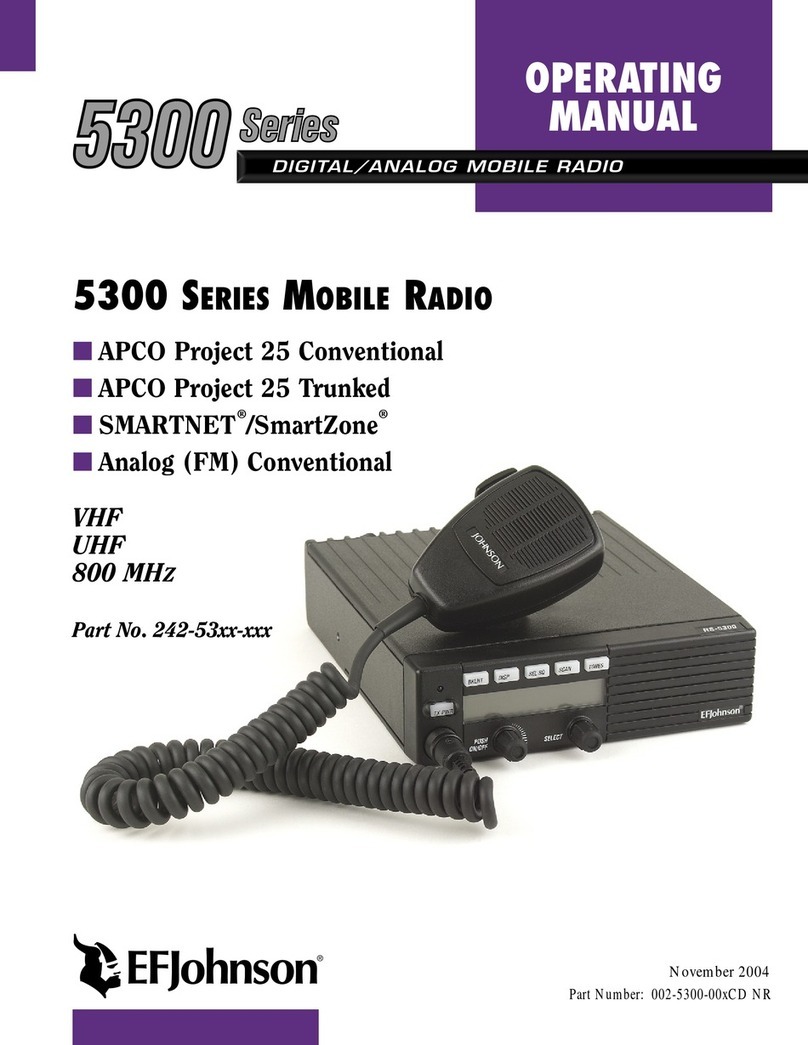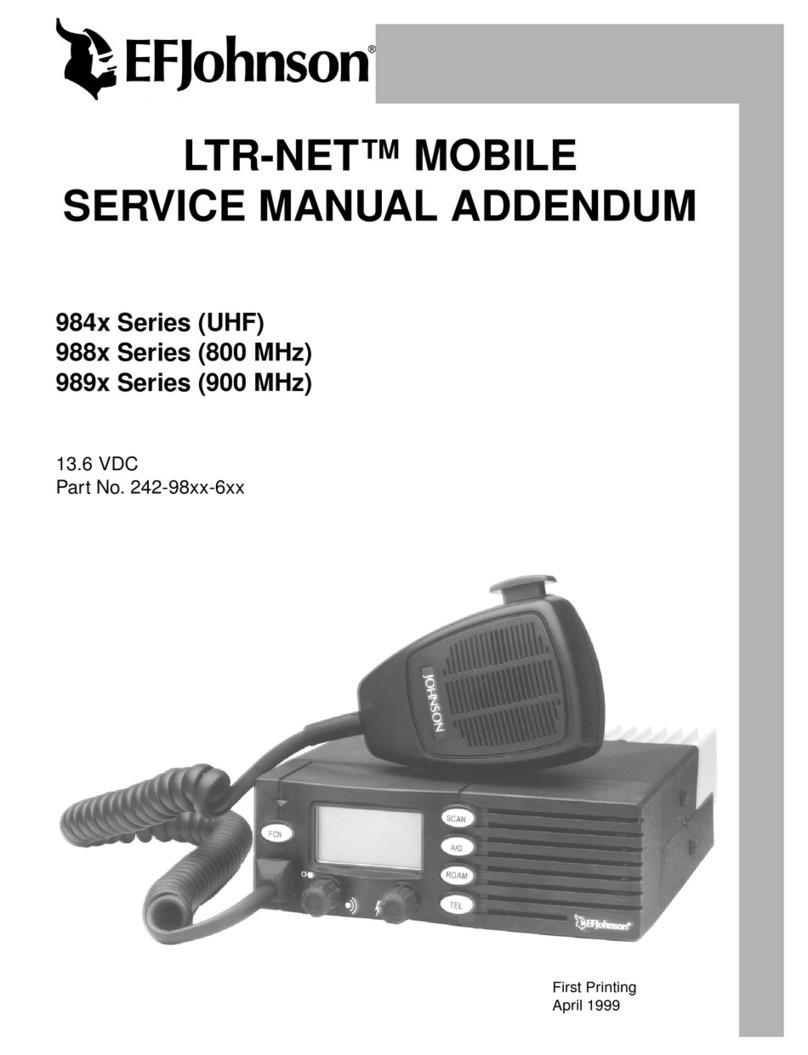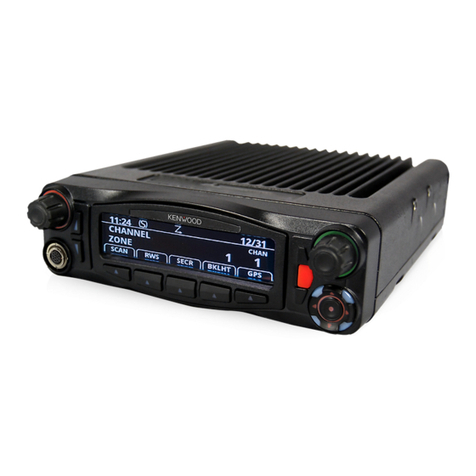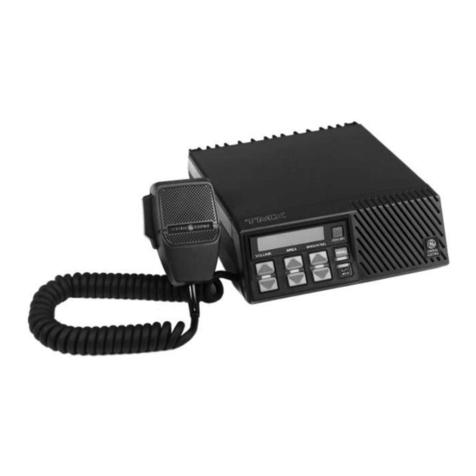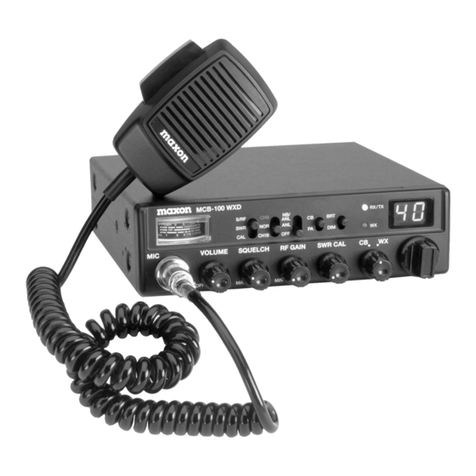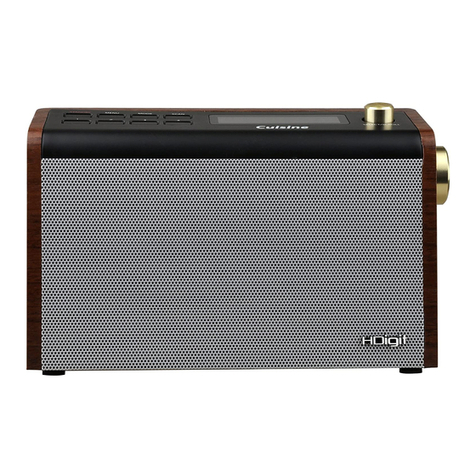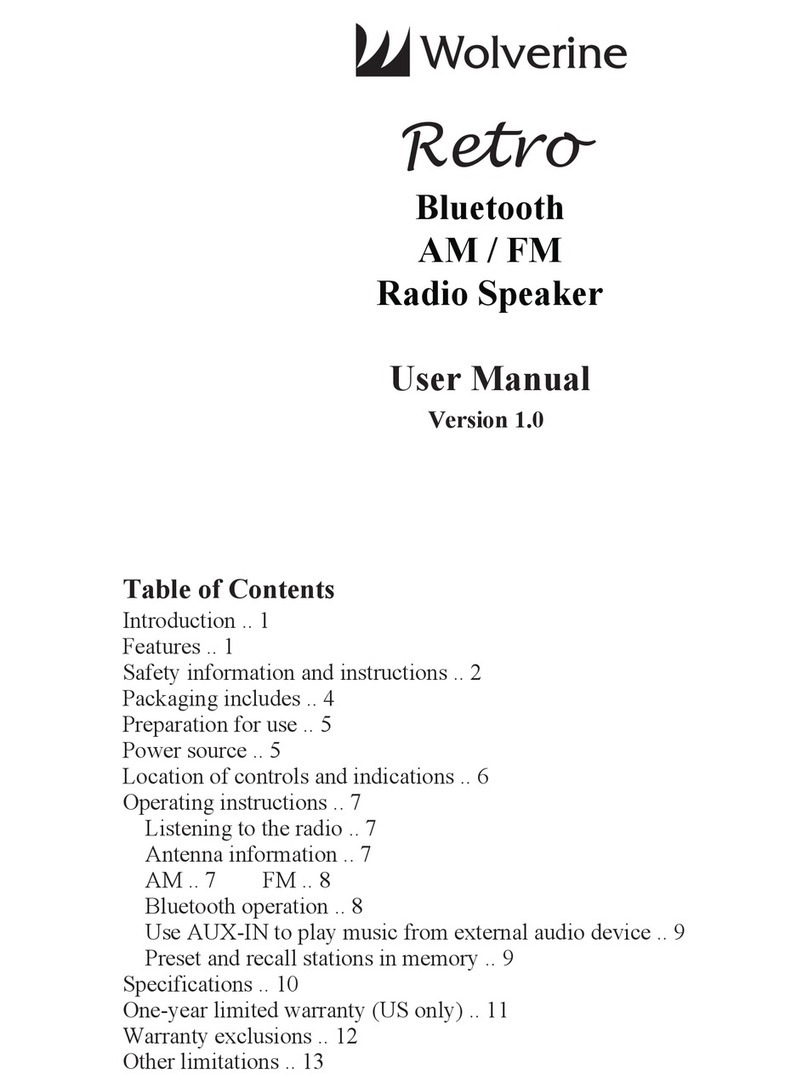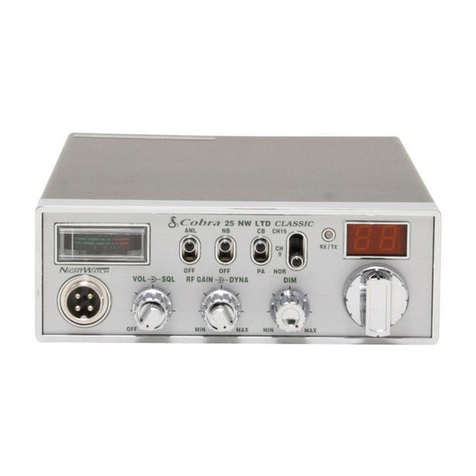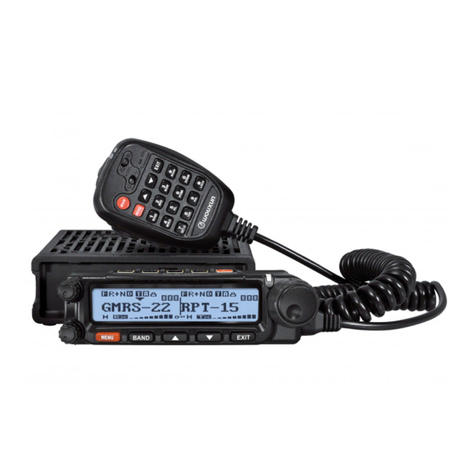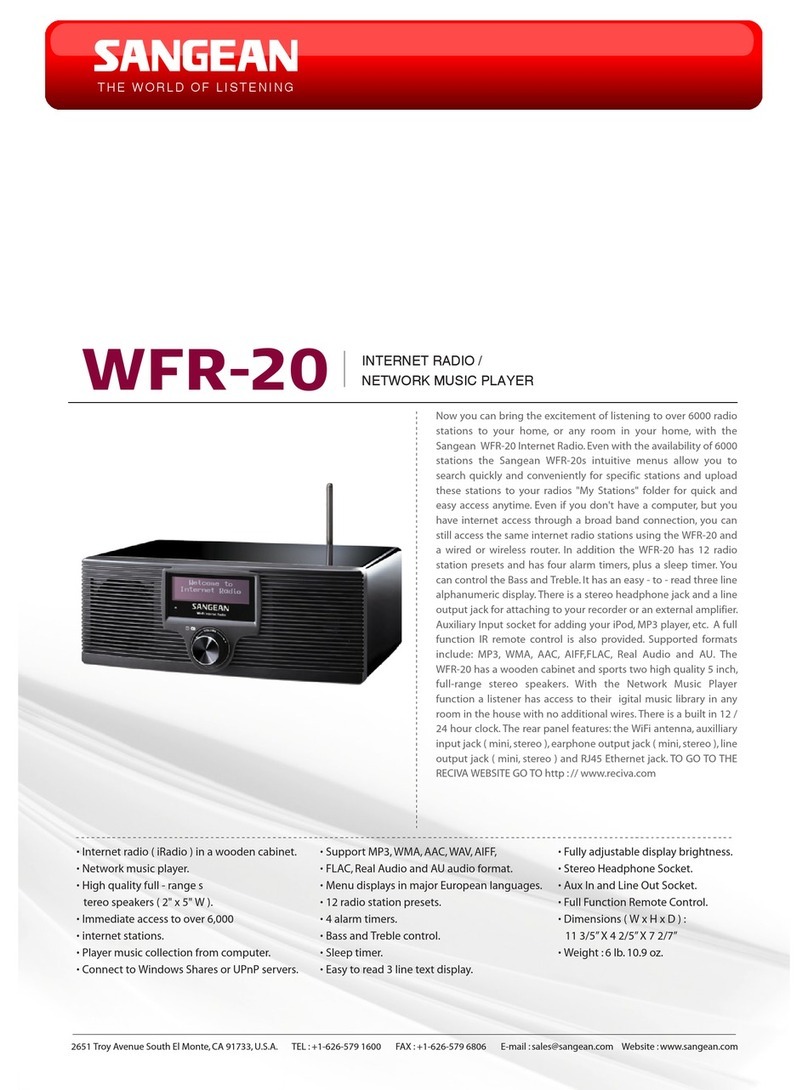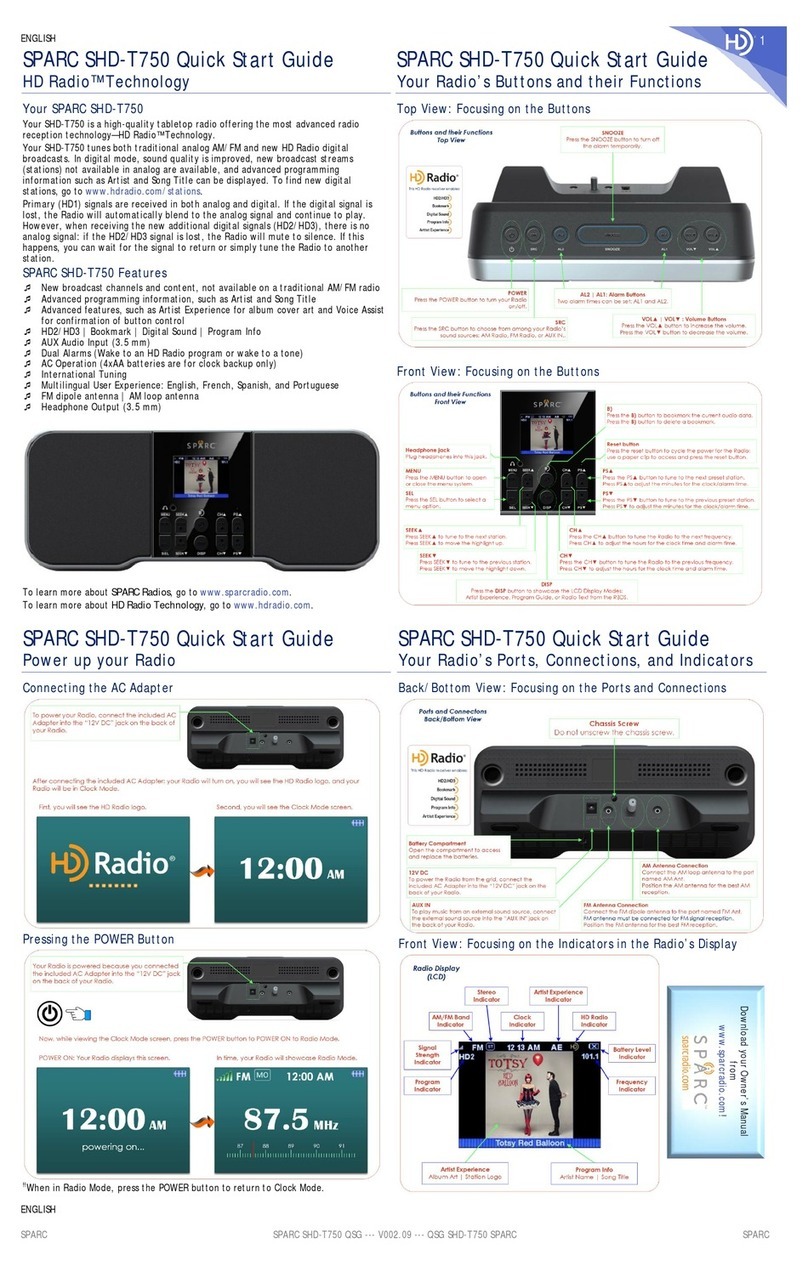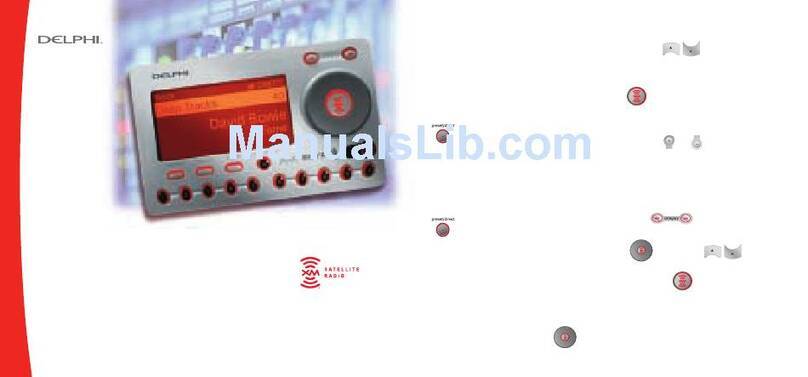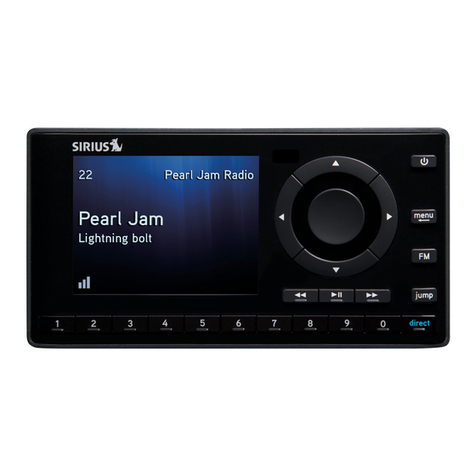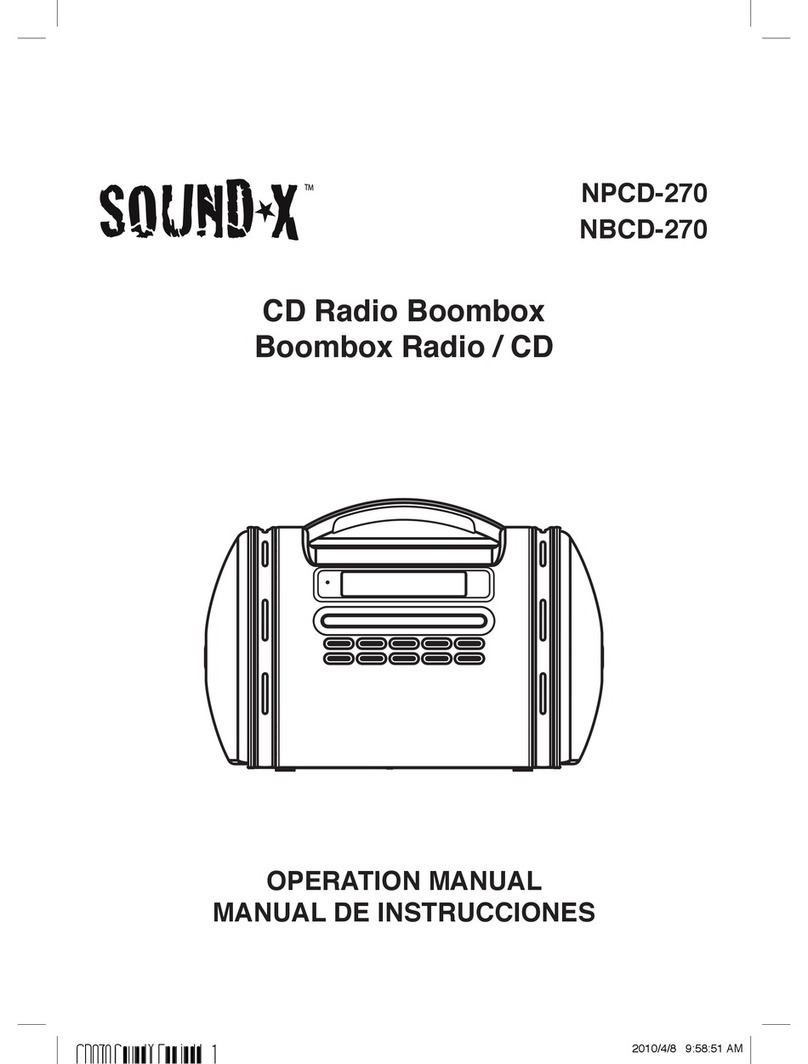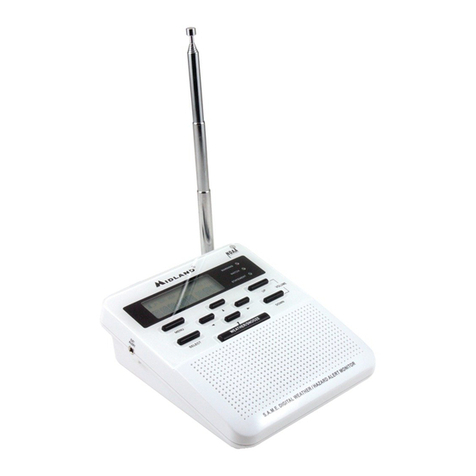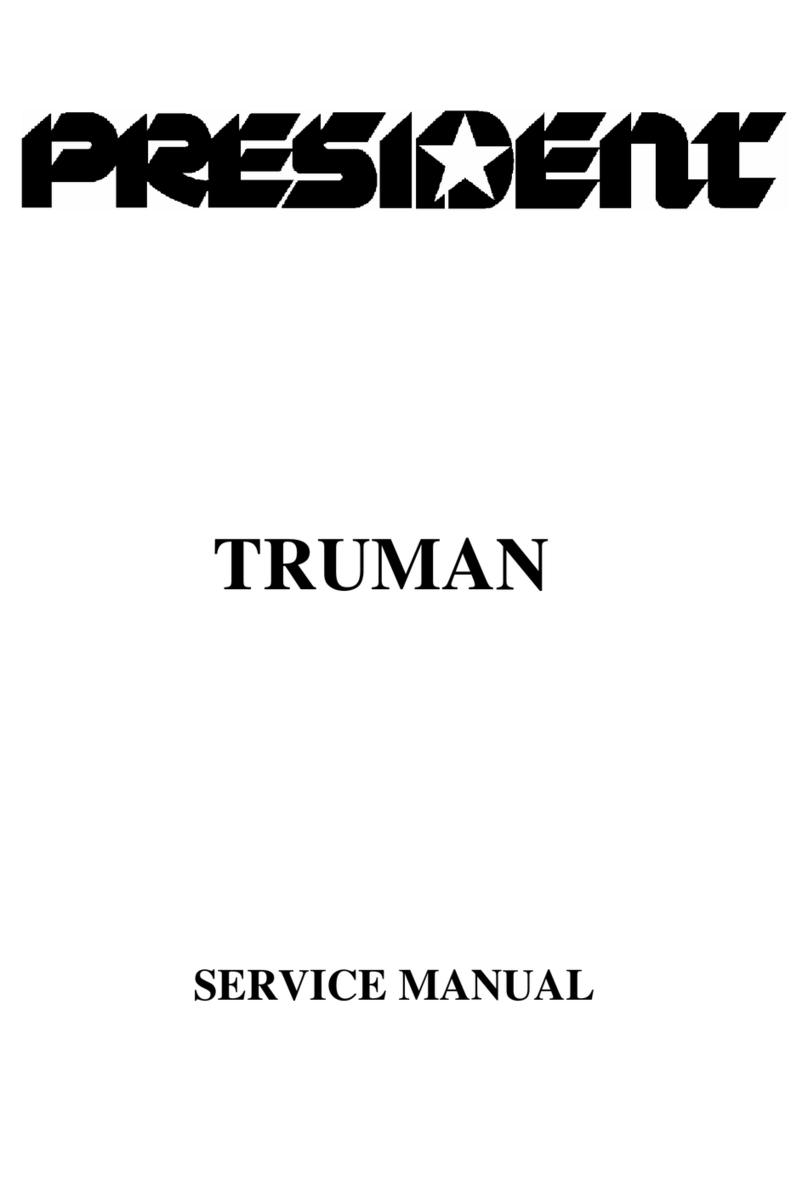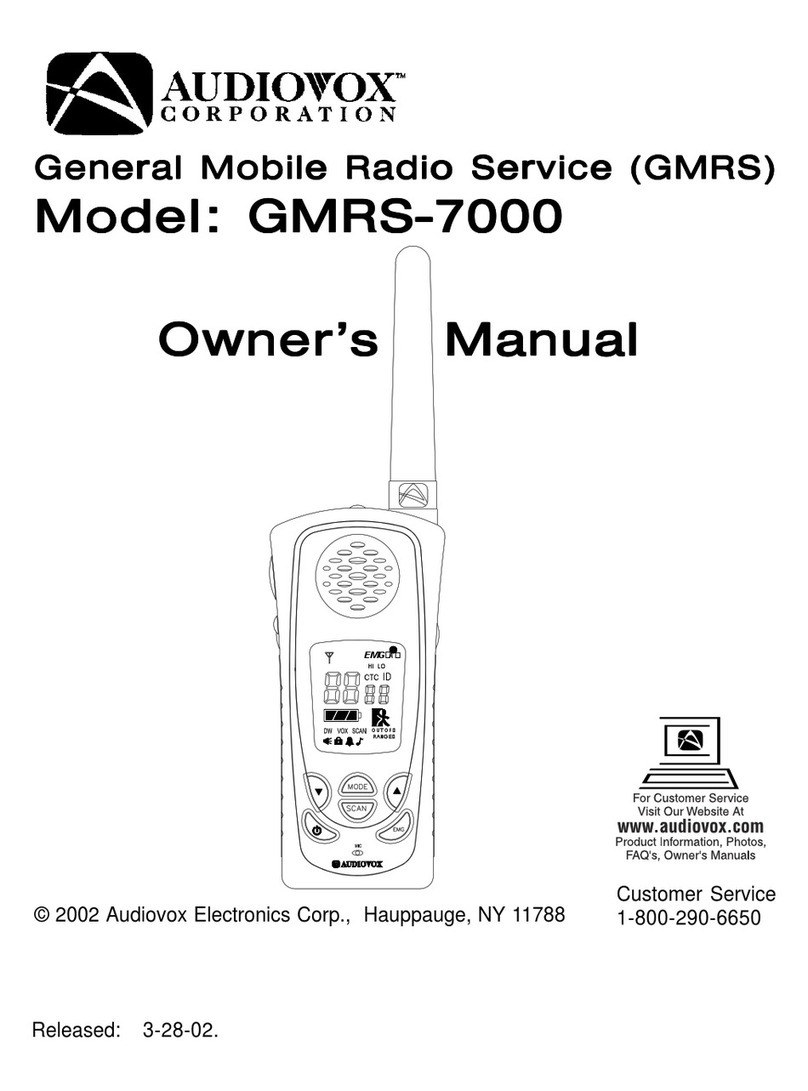E.F. Johnson 2424310 User manual

1
4300 SERIES
MOBILE RADIO
APCO Project 25 Conventional and Trunked
SMARTNET®/SmartZone®
Analog (FM) Conventional
VHF 20 Watts Part No. 242-43xx-xxx
Copyright© 2004 by the E.F. Johnson Company
The EFJohnson Company, which was founded in 1923, provides wireless communication sys-
tems solutions for public safety, government, and commercial customers. The company designs,
manufactures, and markets conventional and trunked radio systems, mobile and portable
subscriber radios, repeaters, and Project 25 digital radio products. EFJohnson is a wholly owned
subsidiary of EFJ, Incorporated.
Viking Head/EFJohnson logo, Call Guard
®
, PCConfigure™, and PCTune™ are trademarks of the
EFJohnson Company. SMARTNET™ and SmartZone
®
are trademarks of Motorola, Inc. All other

2
company and/or product names used in this manual are trademarks and/or registered trademarks
of their respective manufacturer. The IMBE™ voice coding technology embodied in this product is
protected by intellectual property rights including patent rights of Digital Voice Systems, Inc.
Information in this manual is subject to change without notice.

3
TABLE OF CONTENTS
SECTION 1 GENERAL INFORMATION ........................................................................ 6
1.1 SCOPE OF MANUAL............................................................................................. 6
1.2 TRANSCEIVER DESCRIPTION ........................................................................... 6
1.2.1 GENERAL........................................................................................................ 6
1.2.2 ANALOG/DIGITAL OPERATION ................................................................ 6
1.2.3 OPERATING PROTOCOLS ........................................................................... 6
1.2.4 AVAILABLE MOUNTING OPTIONS........................................................... 7
1.2.5 SYSTEMS, CHANNELS, AND ZONES ........................................................7
1.2.6 PROGRAMMING............................................................................................ 8
1.2.7 ALIGNMENT .................................................................................................. 8
1.3 PRODUCT WARRANTY ....................................................................................... 8
1.4 MODEL NUMBER BREAKDOWN....................................................................... 8
1.5 SERIAL NUMBER BREAKDOWN..................................................................... 10
1.6 ACCESSORIES ..................................................................................................... 10
1.7 FACTORY CUSTOMER SERVICE..................................................................... 12
1.8 RETURNS FOR REPAIRS.................................................................................... 13
1.9 REPLACEMENT PARTS ..................................................................................... 14
1.10 INTERNET HOME PAGE .................................................................................. 14
1.11 SECURE COMMUNICATION........................................................................... 14
1.11.1 GENERAL.................................................................................................... 14
1.11.2 FIPS 140-2 APPROVED ENCRYPTION ................................................... 15
1.11.3 OVER-THE-AIR-REKEYING (OTAR)...................................................... 15
1.11.4 KEY RETENTION....................................................................................... 15
1.12 RF SAFETY INFORMATION ............................................................................ 15
1.12.1 FEDERAL COMMUNICATIONS COMMISSION REGULATIONS....... 16
1.12.2 COMPLIANCE WITH RF EXPOSURE STANDARDS ............................ 16
1.12.3 EXPOSURE COMPLIANCE AND CONTROL GUIDELINES AND
OPERATING INSTRUCTIONS ................................................................. 17
1.12.4 MOBILE ANTENNAS ................................................................................ 17
1.12.5 APPROVED ACCESSORIES ..................................................................... 18
1.12.6 CONTACT INFORMATION ...................................................................... 18
4300 SERIES MOBILE SPECIFICATIONS............................................................... 18
SECTION 2 INSTALLATION......................................................................................... 20
2.1 IMPORTANT DIGITAL RADIO INSTALLATION INFORMATION...............20
2.1.1 INTRODUCTION .......................................................................................... 20
2.1.2 INSTALLATION GUIDELINES .................................................................. 20
2.2 GENERAL INFORMATION ................................................................................ 23
2.2.1 SCOPE OF INSTRUCTIONS........................................................................ 23
2.2.2 PERFORMANCE TESTS..............................................................................23
2.2.3 TRANSCEIVER PROGRAMMING ............................................................. 23

4
2.2.4 POWER SOURCE ......................................................................................... 23
2.3 TRANSCEIVER INSTALLATION (FRONT AND REMOTE MOUNT)...........23
2.3.1 MOUNTING CONFIGURATIONS .............................................................. 23
2.3.2 SELECTING A MOUNTING LOCATION .................................................. 25
2.3.3 MOUNTING KITS......................................................................................... 25
2.3.4 MOUNTING STANDARD POWER TRANSCEIVER ................................ 25
2.4 POWER CABLE INSTALLATION...................................................................... 26
2.4.1 STANDARD MODELS ................................................................................. 26
2.5 ACCESSORY CABLE INSTALLATION ............................................................ 26
2.5.1 GENERAL...................................................................................................... 26
2.5.2 IGNITION SENSE INPUT (PIN 6) ............................................................... 27
2.5.3 SPEAKER PINS (PINS 1, 2, 3) ..................................................................... 27
2.5.4 AUXILIARY B OUT (PIN 4) ........................................................................ 27
2.5.5 EXTERNAL PUBLIC ADDRESS (PIN 7).................................................... 28
2.5.6 AUXILIARY B INPUT (PIN 8) .................................................................... 28
2.6 REMOTE CONTROL UNIT INSTALLATION .................................................. 29
2.6.1 GENERAL...................................................................................................... 29
2.6.2 CONTROL UNIT BOARDS.......................................................................... 29
2.6.3 SETTING MASTER/SLAVE SWITCHES ................................................... 31
2.6.4 CONFIGURING VOLUME CONTROL.......................................................31
2.6.5 MOUNTING REMOTE CONTROL UNIT................................................... 31
2.7 CONNECTING THE SPEAKER .......................................................................... 32
2.7.1 USING STANDARD INTERNAL SPEAKER ............................................. 32
2.7.2 USING AN OPTIONAL EXTERNAL SPEAKER ....................................... 32
2.9 TRANSCEIVER MOUNTING TRAY INSTALLATION.................................... 33
2.9.1 DESCRIPTION .............................................................................................. 33
2.9.2 INSTALLATION ........................................................................................... 33
2.10 HANDHELD CONTROL UNIT INSTALLATION ........................................... 34
2.10.1 GENERAL.................................................................................................... 34
2.10.2 INSTALLATION INSTRUCTIONS ........................................................... 35
2.10.3 USING HHC TO PROVIDE DUAL CONTROLS OR DUAL REMOTES36
2.10.4 TRANSCEIVER PROGRAMMING WITH HHC ...................................... 37
2.11 SIREN OPTION INSTALLATION INSTRUCTIONS....................................... 37
2.11.1 GENERAL.................................................................................................... 37
2.11.2 TRANSCEIVER PROGRAMMING ........................................................... 37
2.11.3 INSTALLATION PROCEDURE ................................................................ 37
SECTION 3 OPERATION ............................................................................................... 40
3.1 GENERAL ............................................................................................................. 40
SECTION 4 TRANSCEIVER PROGRAMMING .......................................................... 41
4.1 GENERAL ............................................................................................................. 41
4.1.1 PROGRAMMING SETUP............................................................................. 41
4.1.2 COMPUTER DESCRIPTION ....................................................................... 41
4.1.3 CONNECTING COMPUTER TO TRANSCEIVER..................................... 42
4.1.4 HANDHELD CONTROLLER PROGRAMMING SETUP.......................... 42
4.1.5 SIREN PROGRAMMING ............................................................................. 43
4.2 USING THE PCCONFIGURE SOFTWARE........................................................ 43

5
SECTION 5 CIRCUIT DESCRIPTION ........................................................................... 44
5.1 GENERAL TRANSCEIVER DESCRIPTION...................................................... 44
5.1.1 INTRODUCTION .......................................................................................... 44
5.1.2 PC BOARDS .................................................................................................. 44
5.1.3 CIRCUIT PROTECTION (FUSES)............................................................... 45
5.1.4 ANALOG MODE........................................................................................... 45
5.1.5 PROJECT 25 DIGITAL MODE .................................................................... 45
5.2 VHF BOARDS....................................................................................................... 46
5.2.1 VHF RF BOARD ........................................................................................... 46
5.2.1.1 RECEIVER............................................................................................. 46
5.2.1.2 SYNTHESIZER...................................................................................... 48
5.2.1.3 TRANSMITTER ....................................................................................49
5.2.2 VHF 20-WATT PA BOARD ......................................................................... 50
5.2.2.1 VARIABLE ATTENUATOR ................................................................ 50
5.2.2.2 PA RF DEVICE (Q6) ............................................................................. 51
5.2.2.3 FORWARD POWER DETECTOR, ANTENNA SWITCH, LOW-PASS
FILTER................................................................................................... 51
5.2.2.4 POWER CONTROL............................................................................... 51
SECTION 6 ALIGNMENT PROCEDURE ..................................................................... 54
6.1 GENERAL ............................................................................................................. 54
6.1.1 INTRODUCTION .......................................................................................... 54
6.1.2 TUNE SOFTWARE ....................................................................................... 54
6.1.3 PCTUNE VERSION REQUIRED ................................................................. 55
6.2 MAIN SCREEN ..................................................................................................... 55
6.3 MENU BAR DESCRIPTION ................................................................................ 57
6.3.1 FILE MENU ................................................................................................... 57
6.3.2 RADIO MENU............................................................................................... 57
6.3.3 TRANSFER MENU ....................................................................................... 57
6.3.4 TOOLS MENU............................................................................................... 58
6.3.5 HELP MENU ................................................................................................. 59
6.4 TUNING PROCEDURE........................................................................................ 59
6.4.1 CONNECTING TEST SETUP ...................................................................... 59
6.4.2 STARTING AND CONFIGURING PCTUNE.............................................. 60
6.5 DIGITAL PERFORMANCE TESTS ....................................................................60
6.5.1 GENERAL...................................................................................................... 60
6.5.2 RECEIVE TEST SETUP................................................................................ 61
6.5.3 RECEIVE SENSITIVITY TEST ................................................................... 61
6.5.4 TRANSMITTER TESTS ...............................................................................61
6.6 ANALOG PERFORMANCE TESTS.................................................................... 62
6.6.1 GENERAL...................................................................................................... 62
6.6.2 RECEIVER PERFORMANCE TESTS ......................................................... 62
6.6.3 TRANSMITTER PERFORMANCE TESTS................................................. 63
SECTION 7 PARTS LIST ................................................................................................ 65
SECTION 8 SCHEMATIC DIAGRAMS AND COMPONENT LAYOUTS ............... 102

6
SECTION 1 GENERAL INFORMATION
1.1 SCOPE OF MANUAL
This service manual contains operation, programming, alignment, and service information
for the E.F. Johnson Company 4300 series VHF mobile radio.
1.2 TRANSCEIVER DESCRIPTION
1.2.1 GENERAL
The 4300 series mobile transceivers operate on various types of channels and with various
signaling protocols (see following information).
VHF: 136-174 MHz, 20 watts
1.2.2 ANALOG/DIGITAL OPERATION
The 4300 transceivers use a digital signal processor (DSP) to provide IF and audio filtering
and signal modulation functions. This allows operation on the following types of channels,
backwards compatibility with existing equipment, and also the ability to operate on various types
of radio systems.
Narrow Band Analog - FM modulation is used with a maximum deviation of 2.5 kHz. This
mode is usually used in systems with a channel spacing of 12.5 or 15 kHz.
Wideband Analog - FM modulation is used with a maximum deviation of 5 kHz. This mode is
usually used in systems where the channel spacing is 25 kHz or 30 kHz.
Project 25 Digital - Operates on Project 25 compatible systems. The voice is digitized, error
corrected, optionally encrypted, and then transmitted using C4FM modulation according to the
Project 25 standard. This mode uses a channel spacing of 12.5 kHz.
1.2.3 OPERATING PROTOCOLS
The 43xx transceivers can be programmed for all the following operating protocols. The
conventional analog protocol is standard and the others are optional (available only if enabled by
factory programming). Refer to Section 3 for more operation information.
.• Conventional analog
.• Conventional Project 25 (digital)
.• Trunked Project 25 (digital)
.• Trunked SMARTNET®/SmartZone®analog or digital

7
1.2.4 AVAILABLE MOUNTING OPTIONS
Front Mount - The operating controls are on the front on the radio, so the radio must be mounted
within reach of the user.
Remote Mount, Single Control Unit - The operating controls are located on a remote mounted
control unit. The radio does not have operating controls.
Remote Mount, Dual Controls - A remote control unit is connected to the front mount radio.
This allows control from the front panel and the remote control unit.
Remote Mount, Dual Remote Control Units - Two remote control units are connected to the
remote mount radio. This allows control from both remote control units.
1.2.5 SYSTEMS, CHANNELS, AND ZONES
A zone and channel are selected to place and receive calls. The following describes the
relationship between systems, channels, and zones.
Systems
A system is a collection of channels or talk groups belonging to the same repeater site. It
defines all the parameters and protocol information required to access a site. Up to 16 systems of
any type can be programmed. The maximum number of channels assignable to a system is limited
to approximately 256 (or the available memory space as described in the following information).
Channels
A channel selects a radio channel or talk group in a system as follows:
Conventional Analog Mode - A channel selects a specific radio channel, Call Guard
[Continuous Tone Coded Squelch System (CTCSS)/Digital Coded Squelch (DCS)] squelch
coding, and other parameters unique to that channel.
Conventional Project 25 Mode - A channel selects a specific radio channel, NAC squelch
coding, talk group ID, and other parameters unique to that channel.
Trunked Project 25 Mode - A channel selects a specific talk group ID and other parameters
unique to that talk group.
SMARTNET/SmartZone and Project 25 Trunked Operation - A channel selects a specific
talk group, announcement group, emergency group, and other parameters unique to that talk
group.
As previously described, a maximum of up to 256 channels can be programmed. Although it
is theoretically possible to program any combination of systems that produces up to 256 total
channels, the maximum number may be limited by the available memory. For example, since
more memory is required to program a SMARTNET system than a conventional system, the total
number of channels decreases as the number of SMARTNET systems increases. The

8
programming software displays a bar graph which shows the amount of available memory space
that is used by the current data. Refer to Section 4 for more information.
Zones
A zone is a collection of up to 16 channels of any type. For example, a zone could include 12
conventional channels and 4 SMARTNET channels. One use of zones may be to program the
channels used for operation in a specific geographical area. Up to 16 zones can be programmed.
1.2.6 PROGRAMMING
Transceiver programming is performed using a PC-compatible computer and an EFJohnson
Remote Programming Interface (RPI) and PC Configure programming software (see Table 1-1).
Programming is described in a separate included manual. Refer to Section 4 for more
information.
1.2.7 ALIGNMENT
Transceiver alignment is performed using the same computer and RPI used for programming
(see preceding section) and special PCTune™software. All adjustments are made electronically
using the software (no manual adjustments are required). Alignment is described in Section 6.
1.3 PRODUCT WARRANTY
The warranty statement for this transceiver is available from your product supplier or from
the Warranty Department, E.F. Johnson Company, 1440 Corporate Drive, Irving, TX 75038-
2401. This information may also be requested from the Warranty Department by phone as
described in Section 1.7. The Warranty Department may also be contacted for Warranty Service
Reports, claim forms, or any other questions concerning warranties or warranty service.
1.4 MODEL NUMBER BREAKDOWN
The radio model number is located on the radio identification label attached to the bottom
cover (see Figure 1-1). The following is a breakdown of this number:
[Insert label graphic here]
Figure 1-1 Identification Label Example
242-5MFT-SEC-OADE

9
M (Model)
3 - 4300 Series
F (Frequency Band)
1 - VHF (136-174 MHz)
T (Type of Installation)
7 - Standard Power, Dash Mount
8 - Standard Power, Remote Mount
9 - Standard Power, Dash Mount Public Works
S (Signaling Protocol, Primary)
2 – Project 25 Conventional Analog/Digital
4 - Special
8 - Analog Mode Only
E (Encryption Type)
0 - No encryption
5 - DES/DES-OFB (SEM or UCM*)
6 - DES/DES-XL/DES-OFB (UCM only*)
7 - DES/DES-OFB/AES (SEM or UCM*)
8 - DES/DES-XL/DES-OFB/AES (UCM only*)
C (Control Unit Configuration)
1 - Six button standard control unit
4 - Dual Controls (Front + Remote)
5 - Handheld Control Unit (HHC)
6 - Dual Remote (Two Remote Control Units)
7 - Transit Bus System
O (Optional Cables – Factory Installed)
A - No installed options
D - Data/Accessory cable (optional cable 597-2002-282, with female DB 9 connector,
required for data option)
S - Siren cable (optional cable 597-2002-231 required for external siren option)
U - UI cable
R - Remote/Accessory cable (optional cable 597-2002-249 for external control of radio from
DB 15 female connector – included standard with remote control unit version of radio.)
A (Additional Signaling)
A - No additional signaling
B - Project 25 and SMARTNET/SmartZone Trunking
C - SMARTNET Trunking
E - SMARTNET/SmartZone Trunking
D (Data Options)
A - No data
B – Project 25 Conventional Mobile Data

10
E (Encryption and Security Software Options)
B - Default [no Over-The-Air-Rekeying (OTAR)]
C - OTAR Project 25 Conventional
D - OTAR Project 25 Trunked/Conventional *
1.5 SERIAL NUMBER BREAKDOWN
The radio serial number is located on the radio identification label attached to the bottom
cover (see Figure 1-1). The following is a breakdown of this number:
1.6 ACCESSORIES
The accessories available for this transceiver are listed in Table 1-1. A brief description of
some of these accessories follows:
Table 1-1 4300 Accessories
Accessory Part No.
Mounting Accessories
Mounting bracket & hardware kit
(standard)
DC power cable & hardware, 22
ft. (standard)
Accessory wire kit
Lockable Mounting Tray
Microphones
Standard amplified dynamic 250-0740-310
DTMF without mem, commercial 589-0016-028
DTMF without mem, env seal
WR805
587-9650-015
Noise canceling, weather resistant 589-0016-592
Desk microphone 589-0012-021
Speakers
External, 5-inch, 15-Watt 3.2 Ω
environmental sealed with plug
for HHC
250-0151-005
External, 5-inch, 15-Watt 3.2 Ω250-0151-006

11
environmental sealed with
terminals for acc cable
Handheld Control Unit and
Siren Controller
Handheld control unit with
junction box and 17 ft control
cable
250-5300-101
Siren controller kit (without
loudspeaker)
250-5300-100
Siren loudspeaker, model TS100
for light bar installation
585-5300-007
Siren loudspeaker, model MS100
compact for behind-grill
installation
585-5300-009
Remote Control Conversion Kit
Dual control kit (convert front
mount to remote or dual controls)
Control station power supplies
15 amp, 117 VAC, 60 Hz (light
duty)
585-4001-202
15 amp, 230 VAC, 50 Hz (light
duty)
585-4001-204
15 amp, 117 VAC (heavy duty) 239-0226-111
15 amp, 230 VAC (heavy duty) 239-0226-211
Programming Accessories
PCConfigure programming
software, CD
023-9998-488
PCTune software, CD (current
logic boards)
023-9998-499
Programming Kit, includes -488
software, -005 cable, CD
programming manual
250-5000-004
Encryption Keyloader and
Accessories
SMA (PDA) keyloader 250-5000-945
SMA keyloader to 4100 radio
cable
023-TBD
SMA keyloader to 4300 radio
cable
023-TBD
Data Cable
Data pigtail cable, female DB9 597-2002-282
Mounting Hardware - The mounting hardware and DC power cable for standard models are
shown in Figure 2-1. A 22-foot (6-meter) DC power cable is used for both front and remote
mount applications. The cable is cut to the required length at installation and any excess
discarded.
The accessory cable plugs into the accessory pigtail of the transceiver, and is used to connect
such things as an external speaker, ignition sense input, and a horn alert. It includes two 22-foot
(6-meter) and three 2-foot (0.6-meter) wires that are connected as required to external points. The
adapter cable is used to connect a 86xx-series power cable to these transceivers.

12
Lockable Mounting Tray - This bracket allows the transceiver to be locked in place to guard
against theft. In addition, it allows it to be easily unlocked and removed from the vehicle. Refer to
Section 2.9 for installation information.
Microphones and Speaker - The microphones in Table 1-1 have an impedance of 620 Ω. All
DTMF microphones are backlighted. The environmentally sealed microphone is sealed against
such things as rain, sand, and dust. The desk microphone can be used for control station
applications.
The external 15-Watt speaker can be used in place of the internal 5-Watt speaker. It is non-
amplified and weatherproof. This speaker is connected to Pins 1 and 2 of the accessory connector
pigtail on the back of the transceiver. Audio power output is 12 Watts with this external speaker
or 5 Watts with the internal speaker.
Control Station Power Supply -With the -4001- medium-duty power supplies, the transceiver
slides into the power supply housing and receives power from banana jacks on the back of the
power supply. The standard power cable is used for connecting power, and the internal
transceiver speaker provides speaker audio.
With the -0226 heavy duty power supplies, the transceiver mounts on a pedestal. The -004
adapter cable is used to connect the transceiver DC and accessory pigtail cables to the power
supply power cable and speaker. The transceiver internal speaker can also be used if desired.
Programming Hardware and Software - The RPI provides the interface between the
programming computer and transceiver. The cables from the RPI to computer and transceiver are
not included with the RPI and must be ordered separately. The transceiver programming software
is available only for computers running Windows®95/98/NT/2000/XP.
Encryption Options –Contact Customer Service for more information on the availability of
encryption modules.
A key loader and an adapter cable are required to load encryption keys. The EFJohnson
Subscriber Management Assistant (SMA) key loader part number is listed in Table 1-1. With
OTAR, the key loader is required to perform the initial load of keys. After that, the keys are
loaded over the air. The adapter cable connects the key loader to the transceiver microphone jack.
Special programming using PCConfigure is also required as described in Section 4.
1.7 FACTORY CUSTOMER SERVICE
The Customer Service Department of the E.F. Johnson Company provides customer
assistance on technical problems and the availability of local and factory repair facilities. Regular
Customer Service hours are 8:00 a.m. - 5:00 p.m. Central Time, Monday-Friday. A technical
support subscription service is available or support can be purchased on an as-needed basis. The
Customer Service Department can be reached using the following telephone numbers:
Toll-Free: (800) 328-3911 (for all products except Multi-Net)
Multi-Net Only: Toll-Free (800) 295-1773
Fax: (972) 818-0639

13
E-Mail: customerservice@efjohnson.com You can also e-mail a person directly if you know
their first initial/last name (example: jsmith@efjohnson.com).
NOTE: Emergency 24-hour technical support is also available at the 800 and preceding numbers
during off hours, holidays, and weekends.
When your call is answered at the E.F. Johnson Company, you will hear a brief message
informing you of numbers that can be entered to reach various departments. This number may be
entered during or after the message using a tone-type telephone. If you have a pulse-type
telephone, wait until the message is finished and an operator will come on the line to assist you.
When you enter some numbers, another number is requested to further categorize the type of
information you need.
You may also contact the Customer Service Department by mail. Please include all
information that may be helpful in solving your problem. The mailing address is as follows:
E.F. Johnson Company
Customer Service Department
1440 Corporate Drive
Irving, TX 75038-2401
1.8 RETURNS FOR REPAIRS
Before you return equipment for repair, contact Customer Service as described in the
preceding section. They may be able to suggest a solution to the problem that will make return of
the equipment unnecessary.
Repair service is normally available through local authorized E.F. Johnson Land Mobile
Radio Service Centers. If local service is not available, the equipment can be returned to the E.F.
Johnson repair depot for repair. However, before returning equipment, contact the Customer
Service Department Repair Depot for the correct “Ship To” address.
Be sure to fill out a Factory Repair Request Form #271 for each unit to be repaired, whether
it is in or out of warranty. These forms are available free of charge by calling Customer Service
(see Section 1.7) or by requesting them when you send a unit in for repair. Clearly describe the
difficulty experienced in the space provided and also note any prior physical damage to the
equipment. Include this form in the shipping container with each unit. Your telephone number
and contact name are important as there are times when the technicians may have specific ques-
tions that need to be answered in order to completely identify and repair a problem.
When returning equipment for repair, it is also recommended that you use a PO number or
some other reference number on your paperwork in case you need to call the repair lab about your
unit. These numbers are referenced on the repair order and make it easier and faster to locate your
unit in the lab.

14
Return Authorization (RA) numbers are not necessary unless you have been given one by
the Field Service Department. RA numbers are required for exchange units or if the Field Service
Department wants to be aware of a specific problem. If you have been given an RA number,
reference this number on the Factory Repair Request Form sent with the unit. The repair lab will
then contact the Field Service Department when the unit arrives.
For additional information on factory service, the Depot Service Department can be
contacted at the following E-mail address:
depotrepair@efjohnson.com
1.9 REPLACEMENT PARTS
Replacement parts can be ordered directly from the Service Parts Department. To order parts
by phone, dial the toll-free number as described in Section 1.7. When ordering, please supply the
part number and quantity of each part ordered. E.F. Johnson dealers also need to give their
account numbers. If there is uncertainty about the part number, include the designator (C512, for
example) and the model number of the equipment the part is from.
You may also send your order by mail or FAX. The mailing address is as follows and the
FAX number is shown in Section 1.7.
E.F. Johnson Company
Service Parts Department
1440 Corporate Drive
Irving, TX 75038-2401
1.10 INTERNET HOME PAGE
The E.F. Johnson Company has a site on the World Wide Web that can be accessed for
information on the company about such things as products, systems, and regulations. The address
is http://www.efjohnson.com.
1.11 SECURE COMMUNICATION
1.11.1 GENERAL
SecureNet™ and Advanced Encryption Standard (AES) voice encryption are used to provide
secure communication with this transceiver. These protocols digitize the voice and then encrypt it
using an AES or Data Encryption Standard (DES) algorithm. The following types of encryption
are available on analog and digital channels:
Analog Conventional and SMARTNET/SmartZone Analog Channel
•DES

15
Digital Project 25 and SMARTNET/SmartZone Channels
•DES-OFB (Output Feedback)
•AES
1.11.2 FIPS 140-2 APPROVED ENCRYPTION
All encrypted 4300 models are Federal Information Processing Standard (FIPS) certified for
the DES-OFB and AES encryption modes. Encryption on analog channels is not FIPS certified.
FIPS 140-02 is approved by the United States Secretary of Commerce. This standard specifies
federal security requirements for cryptographic modules for a wide range of applications and
environments.
1.11.3 OVER-THE-AIR-REKEYING (OTAR)
Encryption keys are loaded into the radio by Over-The-Air-Rekeying (OTAR) using a
KMF (Key Management Facility) and/or a handheld keyloader such as the EFJohnson SMA
(Subscriber Management Assistant) or Motorola KVL 3000 Plus with the AES option.
The keyloader is connected directly to the radio using an interconnect cable, and it loads
DES, DES-OFB, and AES keys. OTAR can be used to load DES-OFB keys on Project 25
conventional channels
1.11.4 KEY RETENTION
NOTE: The 4300 radio has a security feature (pushbutton switch S1 on the logic board) that
automatically erases the encryption keys when the bottom cover is removed (except when Infinite
Key Retention is programmed as follows).
If Infinite Key Retention is programmed, the keys are maintained in memory indefinitely,
even without power applied. If it is not programmed, the transceiver must be connected to an
unswitched power source to preserve the encryption keys in memory. However, a storage
capacitor (C173) maintains the 5-volt supply (and the encryption keys) for approximately 8
hours if power is temporarily lost.
1.12 RF SAFETY INFORMATION
Before using your mobile two-way radio, read this important RF energy awareness and
control information and operational instructions to ensure compliance with the FCC’s RF
exposure guidelines.
NOTICE: This radio is intended for use in occupational/controlled conditions, where users have
full knowledge of their exposure and can exercise control over their exposure to meet FCC limits.
This radio device is NOT authorized for general population, consumer, or any other use.
This two-way radio uses electromagnetic energy in the radio frequency (RF) spectrum to
provide communications between two or more users over a distance. It uses radio frequency (RF)

16
energy or radio waves to send and receive calls. RF energy is one form of electromagnetic
energy. Other forms include, but are not limited to, electric power, sunlight and x-rays. RF
energy, however, should not be confused with these other forms of electromagnetic energy, which
when used improperly can cause biological damage. Very high levels of x-rays, for example, can
damage tissues and genetic material.
Experts in science, engineering, medicine, health and industry work with organizations to
develop standards for exposure to RF energy. These standards provide recommended levels of RF
exposure for both workers and the general public. These recommended RF exposure levels
include substantial margins of protection. All two-way radios marketed in North America are
designed, manufactured and tested to ensure they meet government established RF exposure
levels. In addition, manufacturers also recommend specific operating instructions to users of two-
way radios. These instructions are important because they inform users about RF energy exposure
and provide simple procedures on how to control it.Please refer to the following web sites for
more information on what RF energy exposure is and how to control your exposure to assure
compliance with established RF exposure limits.
http://www.fcc.gov/oet/rfsafety/rf-faqs.html
http://www.osha.gov/SLTC/radiofrequencyradiation/index.html
1.12.1 FEDERAL COMMUNICATIONS COMMISSION REGULATIONS
The FCC rules require manufacturers to comply with the FCC RF energy exposure limits for
mobile two-way radios before they can be marketed in the U.S. When two-way radios are used as
a consequence of employment, the FCC requires users to be fully aware of and able to control
their exposure to meet occupational requirements. Exposure awareness can be facilitated by the
use of a label directing users to specific user awareness information. Your EFJohnson two-way
radio has a RF exposure product label. Also, your EFJohnson user manual, or product manual, or
separate safety booklet includes information and operating instructions required to control your
RF exposure and to satisfy compliance requirements.
1.12.2 COMPLIANCE WITH RF EXPOSURE STANDARDS
Your EFJohnson two-way radio is designed and tested to comply with a number of national
and international standards and guidelines (listed below) regarding human exposure to radio
frequency electromagnetic energy. This radio complies with the IEEE and ICNIRP exposure
limits for occupational/controlled RF exposure environment at duty factors of up to 50% talk and
100% listen and is authorized by the FCC for occupational use. In terms of measuring RF energy
for compliance with the FCC exposure guidelines, your radio antenna radiates measurable RF
energy only while it is transmitting (during talking), not when it is receiving (listening) or in
standby mode.
Your EFJohnson two-way radio complies with the following RF energy exposure standards
and guidelines:
•United States Federal Communications Commission, Code of Federal Regulations; 47 CFR §§
2 sub-part J.

17
•American National Standards Institute (ANSI) / Institute of Electrical and Electronic
Engineers (IEEE) C95. 1-1992.
•Institute of Electrical and Electronic Engineers (IEEE) C95.1-1999 Edition.
1.12.3 EXPOSURE COMPLIANCE AND CONTROL GUIDELINES AND
OPERATING INSTRUCTIONS
To control exposure to yourself and others and ensure compliance with the
occupational/controlled environment exposure limits always adhere to the following procedures.
Guidelines:
•User awareness instructions should accompany device when transferred to other users.
•Do not use this device if the operational requirements described herein are not met.
Instructions:
•Transmit no more than the rated duty factor of 50% of the time. To transmit (talk), push the
Push-To-Talk (PTT) button. To receive calls, release the PTT button. Transmitting 50% of the
time, or less, is important because this radio generates measurable RF energy exposure only
when transmitting (in terms of measuring for standards compliance).
•Transmit only when people outside the vehicle are at least the recommended minimum lateral
distance away, as shown in Table 1, from a properly installed according to installation
instructions, externally-mounted antenna.
NOTE: Table 1-2 lists the recommended minimum lateral distance for bystanders in an
uncontrolled environment from transmitting types of antennas (i.e., monopoles over a ground
plane, or dipoles) at several different ranges of rated radio power for mobile radios installed in a
vehicle.
Table 1-2 Rated Power and Recommended Lateral Distance
Rated Power of Vehicle-Installed
Two-Way Radio
Recommended Minimum Lateral
Distance From Transmitting
Antenna
Up to 50 watts 40 inches (1.0 meter)
1.12.4 MOBILE ANTENNAS
•Install antennas at the center of the roof or the center of the trunk deck taking into account the
bystander exposure conditions of backseat passengers and the recommended minimum lateral
distances in Table 1-2. These mobile antenna installation guidelines are limited to metal body
motor vehicles or vehicles with appropriate ground planes. The antenna installation should
additionally be in accordance with:
a.) The requirements of the antenna manufacturer/supplier.
b.) Instructions in the Radio Installation Manual, including minimum antenna cable lengths.

18
c.) The installation manual should provide specific information of how to install the
antennas to facilitate recommended operating distances to all potentially exposed
persons.
•Use only EFJohnson approved supplied antenna or EFJohnson approved replacement antenna.
Unauthorized antennas, modifications, or attachments could damage the radio and may violate
FCC regulations. Antennas tested with EFJohnson radios are listed in Table 1-2.
Table 1-2 Tested Antenna Whips and Bases
(Antenna Manufacturer - Antenna Specialists)
Frequency Whip Model No. Base Model No.
136-144 MHz ASPJ1415 KM220
144-152 MHz ASPA1415 KM220
152-162 MHz ASPB1415 KM220
162-174 MHz ASPC1415 KM220
400-430 MHz ASPE1615 KM220
430-470 MHz ASPD1615 KM220
470-512 MHz ASPF1615 KM220
806-869 MHz ASPA1855 KM220
890-960 MHz ASPG1865 KM220
1.12.5 APPROVED ACCESSORIES
•This radio has been tested and meets the FCC RF exposure guidelines when used with the
EFJohnson accessories supplied or designated for this product. Use of other accessories may
not ensure compliance with the FCC’s RF exposure guidelines, and may violate FCC
regulations.
•For a list of EFJohnson approved accessories, refer to the radio service manual or contact the
EFJohnson Company as follows.
1.12.6 CONTACT INFORMATION
For additional information on exposure requirements or other information, contact the
EFJohnson Company at the address or telephone number listed in Section 1.7.
4300 SERIES MOBILE SPECIFICATIONS
The following are general specifications intended for use in testing and servicing this
transceiver. For current advertised specifications, refer to the specification sheet available from
your sales representative. Values are typical and are subject to change without notice.
GENERAL
Frequency Range VHF: 136-174 MHz
Operating Modes Conventional, Project 25 Conventional, Project 25 Trunked,
SMARTNET, SmartZone

19
Mounting Location Dash Mount (Remote mount optional)
Zones/Channels Up to 16 zones with 16 channels per zone
Transmit/Receive Separation Any frequency within the range
Channel Spacing 12.5, 15, 25, and 30 kHz
Maximum Deviation 25 kHz analog - 5 kHz
12.5 kHz analog - 2.5 kHz
Frequency Stability Receive
and Transmit
2.5 PPM [–22° to +140° F (–30° to +60° C)]
Dimensions (without antenna) 2.1 inches high x 7.2 inches wide x 8.3 inches deep
(5.3 cm x 18.2 cm x 21.1 cm)
Weight (with standard battery) 5 lbs. 4 oz. (2.38 kg)
Supply Voltage 13.6 volts DC nominal, negative ground
Current Drain (maximum) Standby - 600 mA
Receive (rated audio out) - 2.7 A
Rated Transmit Power - 13.2 A
RECEIVER
Sensitivity 0.35 µV (analog mode 12 dB SINAD), 0.35 µV (digital mode 5% BER)
Selectivity –75 dB
Spurious and Image Rejection –75 dB
Intermodulation –75 dB
Hum and Noise 40 dB at 25 kHz, 34 dB at 12.5 kHz
Maximum Frequency Spread Any spread within the range
Audio Power Output 5 W with internal speaker (12 W with external 4-Ωspeaker)
Audio Distortion Less than 3% at 1 kHz
TRANSMITTER
RF Power Output 10 - 50 W variable standard
Spurious and Harmonic
Emissions –70 dB
FM Hum and Noise –45 dB at 25 kHz bandwidth
Audio Modulation 8K10F1E, 11K0F3E, 16K0F3E, 20K0F1E
Audio Distortion Less than 3% at 1 kHz
Maximum Frequency Spread Any spread within the band

20
SECTION 2 INSTALLATION
2.1 IMPORTANT DIGITAL RADIO INSTALLATION INFORMATION
2.1.1 INTRODUCTION
With digital radios such as the 4300, electrical noise on the DC power line is heard as a
“warbling” sound in messages received from a radio in a vehicle with this problem. It is not the
typical alternator whine or ignition ticking heard with analog radios.
NOTE: For proper digital radio operation, the noise level at the battery and power connector of
the radio should be 50 mV or less when measured by an oscilloscope.
2.1.2 INSTALLATION GUIDELINES
Much of this electrical noise is caused by improper radio installation techniques. Observing the
installation guidelines which follow minimizes the degradation of radio performance caused by
vehicle electrical noise. If noise is still a problem after following these guidelines, try installing a
noise filter such as EFJohnson 17-Ampere In-Line Noise Filter, Part No. 517-2003-017.
• Connect both wires of the power cable directly to the vehicle battery as shown in the photo on
the following page. Use a minimum length of cable.
• Do not connect the power cable to a switched power source such as a kill switch because de-
affiliation and proper saving of some parameters then does not occur at power off. Use the
ignition sense line to switch power as described in “ACCESSORY CABLE INSTALLATION”
on page ???. Current drain in the off mode with this configuration is only about 0.75 mA.
• Do not route the power cable and coaxial cable in the same bundle except when required such
as to get through a firewall. Keep this type of routing short and close to the radio. Do not coil up
extra power cable and attach it to other wires or coaxial cable. Use only the minimum length of
cable required.
• Mount the antenna on the roof or center of the trunk lid and at least 5 feet (1.5 meters) from
other antennas. Do not mount it on a light bar, next to a video camera, or on a small “L” bracket
on the fender lip.
• Do not use adapters to connect the antenna to the Type N antenna jack of the radio. Change the
antenna connector to the correct type if required.
Table of contents
Other E.F. Johnson Radio manuals
